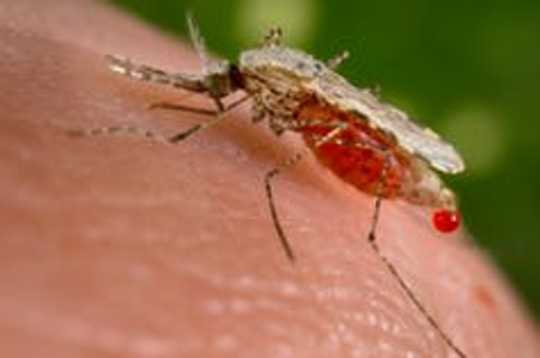 Spraying insecticide to kill mosquitoes: Mosquitoes are vectors of many devastating diseases such as malaria. Sukjanya/Shutterstock.com
Spraying insecticide to kill mosquitoes: Mosquitoes are vectors of many devastating diseases such as malaria. Sukjanya/Shutterstock.com
Bed nets. Insecticides. Sterile and genetically modified insects. Now scientists are adding a genetically engineered toxic fungus to the arsenal of weapons to wipe out mosquitoes that carry the malaria parasite.
Although insecticides and insecticide-laced bed nets, by far the two most commonly employed strategies, have effectively lowered the numbers of infections and deaths, the global malaria burden has failed to decline in the last few years. In 2017, 219 million people were infected with malaria and an estimated 435,000 died. That is because mosquitoes are evolving resistance to insecticides.
 An Anopheles mosquito taking a blood meal from a human host. It is in the course of these blood meals that mosquitoes transmit malaria to humans. CDC
An Anopheles mosquito taking a blood meal from a human host. It is in the course of these blood meals that mosquitoes transmit malaria to humans. CDC
The rapid evolution of resistance is a common and recurrent theme in our arms races against malaria transmitting mosquitoes, as well as against pests and pathogens in general. Over time, organisms mutate and evolve resistance to any new drug that is used to kill them. No wonder humans always end up on the losing side; that’s why a new weapon is needed. And the latest one is a killer fungus.
Get The Latest By Email
Fighting killers with killers
As an evolutionary biologist studying fungi, I am familiar with the ability of these organisms to cause devastating diseases in diverse plants and animals, including humans. While many fungal pathogens infect a broad range of hosts, others can attack only a select few.
This realization has led scientists to a new strategy for fighting malaria: infect and kill disease-transmitting mosquitoes using fungal pathogens that they encounter in nature. This isn’t the first time that fungi have been weaponized. In fact, this is precisely the strategy behind the highly successful biological pesticide, Green Muscle, which kills locusts and grasshoppers around the world.
Infecting mosquitoes with their natural pathogens – such as the pathogenic fungi from the genus Metarhizium – is a particularly attractive strategy because, unlike bacterial or viral pathogens, fungi can infect mosquitoes simply by coming into contact with them and don’t have to be ingested. Also, fungi are generally friendlier to the environment than traditional chemical insecticides. But does this strategy work?
Fifteen years ago, a field trial in rural Tanzania showed that it could. By hanging cotton sheets inoculated with insect-killing fungi on the ceilings of houses where mosquitoes rest, one-third of mosquitoes became infected. According to malaria transmission models, such an infection rate could reduce malaria cases by 75%.
But Metarhizium fungi, as the Tanzanian field trial showed, are not always capable of infecting their mosquito hosts. And, fungal infections typically take several days to kill mosquitoes. In the lab, fungi take an average of between seven and nine days to kill the mosquitoes, depending on the dose. Brian Lovett, a graduate student working in Ray St. Leger’s lab, and Etienne Bilgo, a post-doctoral fellow working with entomologist Abdoulaye Diabate, thought they could infect more mosquitoes and kill them faster.
How? By using fungi that had been genetically modified to produce a toxin called “Hybrid,” which specifically attacks the nervous system of arthropods, a group that includes insects and their kin, like spiders and crustaceans. Previous laboratory experiments in 2017 by the same team had already shown that these GM fungi killed mosquitoes quicker than unmodified ones.
The big question now was whether it worked in nature.
 The MosquitoSphere team consists of authors on the paper and local volunteers from Soumousso, Burkina Faso. Back row (from left to right): Etienne Bilgo, Oliver Zida, Bema Ouattara; Middle row: Boureima Saré, Judicael Zida, Brian Lovett, Moussa Ouattara, MichaÏlou Sanfo and Bamory Ouattara; Front row: Yaya Ouattara and Jacques Gnambani. Brian Lovett, CC BY-SA
The MosquitoSphere team consists of authors on the paper and local volunteers from Soumousso, Burkina Faso. Back row (from left to right): Etienne Bilgo, Oliver Zida, Bema Ouattara; Middle row: Boureima Saré, Judicael Zida, Brian Lovett, Moussa Ouattara, MichaÏlou Sanfo and Bamory Ouattara; Front row: Yaya Ouattara and Jacques Gnambani. Brian Lovett, CC BY-SA
GM fungi kill mosquitoes faster, crashing populations
To reduce the risks posed by field testing, Lovett and Bilgo tested their GM fungus in the “MosquitoSphere,” a large, specially designed screened-in field designed to closely match outdoor conditions in Soumousso, Burkina Faso. By setting up huts with cotton sheets that contained spores of GM toxin-producing Metarhizium fungi as well as ones with unmodified fungi as controls, Lovett and Bilgo found that 70% to 80% of mosquitoes were infected in both types of huts. But mosquitoes in huts with GM fungi died within an average of five days whereas mosquitoes in huts with unmodified fungi died after close to nine days.
 The huts of MosquitoSphere in Soumousso, Burkina Faso, where the experiments with GM killer toxic fungi took place. Brian Lovett
The huts of MosquitoSphere in Soumousso, Burkina Faso, where the experiments with GM killer toxic fungi took place. Brian Lovett
By examining how mosquito populations fared over time, they also discovered that GM fungi infected multiple generations of mosquitoes. In one enclosure with GM fungi, an initial population of 1,500 mosquitoes, collapsed to just 13 after a month and a half.
Promise and risks
By genetically arming an already deadly fungal pathogen with a powerful toxin, the investigators were able to dramatically reduce the mosquito “field” population in a part of the world where malaria is endemic and mosquitoes are resistant to chemical insecticides.
There is an urgent need to curb malaria transmission particularly in sub-Saharan Africa, where 92% of cases and 93% of deaths occur. Together, the U.S. Environmental Protection Agency’s approval of the Hybrid toxin under the commercial name Versitude, and the approval of the use of unmodified Metarhizium fungi as a “biopesticide” by several African countries, may pave the way to green light the use of genetically modified Metarhizium fungi in the fight against malaria.
On the flip side, releasing fungi carrying a deadly insect toxin raises concerns about unintentional harm to “nontarget” insects. Metarhizium fungi infect only a small range of insects and experiments where nontarget insects, such as honeybees, were infected with both the GM and unmodified fungi did not affect bee survival. Even if the gene found its way into fungi that infect humans – a highly unlikely scenario – it would not have any effects on us because the toxin only works on insects.
Restricting the spread of the gene that produces the Hybrid toxin in organisms other than Metarhizium fungi is another potential concern. One safety precaution could be to add genetic switches that reduce survival of the fungus outside of the indoor environment. But there are also several inherent features of Metarhizium fungi – such as their large, non-airborne and sensitive-to-ultraviolet-light spores – that reduce the chances of dispersal.
While promising, this strategy of essentially poisoning mosquitoes with genetically engineered fungi is not guaranteed. Mosquitoes could evolve resistance to this. But with hundreds of thousands of people dying each year in this deadly game against pathogens, perhaps the only certainty is that, like our opponents, we’ll need to keep evolving our strategies too.![]()
About The Author
Antonis Rokas, Cornelius Vanderbilt Chair in Biological Sciences and Professor of Biological Sciences and Biomedical Informatics, Vanderbilt University
This article is republished from The Conversation under a Creative Commons license. Read the original article.
books_environmental







